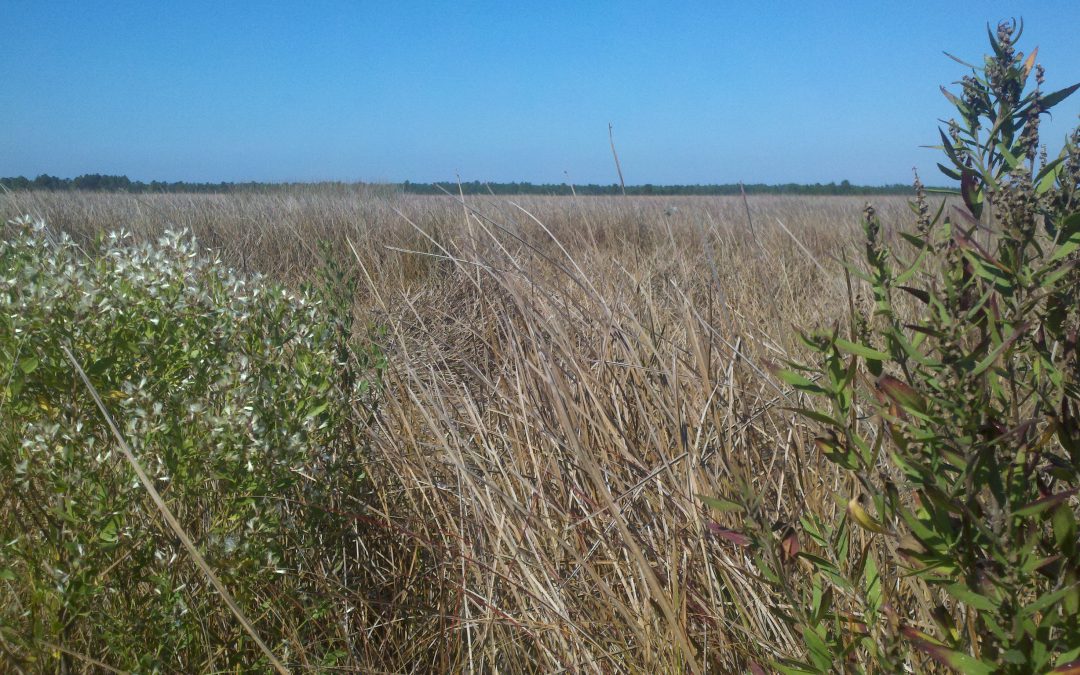
by Carrie Stevenson | Aug 25, 2017
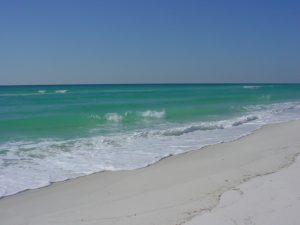
Life on the Gulf Coast can be beautiful, but has its share of complications. Photo credit: Carrie Stevenson, UF IFAS Extension
Life on the coast has tremendous benefits; steady sea breezes, gorgeous beaches, plentiful fishing and paddling opportunities. Nevertheless, there are definite downsides to living along it, too. Besides storms like Hurricane Harvey making semi-regular appearances, our proximity to the water can make us more vulnerable to flooding and waterborne hazards ranging from bacteria to jellyfish. One year-round problem for those living directly on a shoreline is erosion. Causes for shoreline erosion are wide-ranging; heavy boat traffic, foot traffic, storms, lack of vegetation with anchoring roots, and sea level rise.
Many homeowners experiencing loss of property due to erosion unwittingly contribute to it by installing seawalls. When incoming waves hit the hard surface of the wall, energy reflects back and moves down the coast. Often, an adjacent homeowner will experience increased erosion and bank scouring after a neighboring property installs a seawall. This will often lead that neighbor to install a seawall themselves, transferring the problem further.
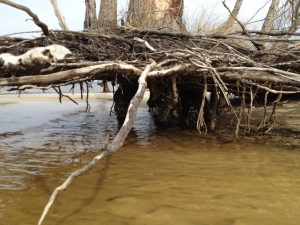
Erosion can damage root systems of shoreline trees and grasses. Photo credit: Carrie Stevenson, UF IFAS Extension
Currently, south Louisiana is experiencing significant coastal erosion and wetlands losses. The problem is compounded by several factors, including canals dredged by oil companies, which damage and break up large patches of the marsh. Subsidence, in which the land is literally sinking under the sea, is happening due to a reduced load of sediment coming down the Mississippi River. Sea level rise has contributed to erosion, and most recently, an invasive insect has caused large-scale death of over 100,000 acres of Roseau cane (Phragmites australis). Add the residual impacts from the oil spill, and you can understand the complexity of the situation.
Luckily, there are ways to address coastal erosion, on both the small and large scale. On Gulf and Atlantic beaches, numerous coastal communities have invested millions in beach renourishment, in which offshore sand is barged to the coast to lengthen and deepen beaches. This practice, while common, can be controversial because of the cost and risk of beaches washing out during storms and regular tides. However, as long as tourism is the #1 economic driver in the state, the return on investment seems to be worth it.
On quieter waters like bays and bayous, living shorelines have “taken root” as a popular method of restoring property and stabilizing shorelines. This involves planting marsh grasses along a sandy shore, often with oyster or rock breakwaters placed waterward to slow down wave energy, and allow newly planted grasses to take root.
Locally in Bayou Grande, a group of neighbors were experiencing shoreline erosion. Over a span of 50 years, the property owners used a patchwork of legally installed seawalls, bulkheads, rip rap piles, private boat ramps, piers, mooring poles and just about anything else one can imagine, to reduce the problem. Over time, the seawalls and bulkheads failed, lowering the property value of the very property they were meant to protect and increasing noticeable physical damage to the adjacent properties.”
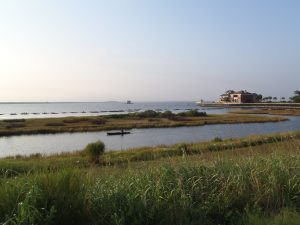
Project Greenshores is a large-scale living shoreline project in Pensacola. Photo credit: Carrie Stevenson, UF IFAS Extension
In 2011, a group of neighboring property owners along the bayou decided to take action. After considering many repair options, the neighbors decided to pursue a living shoreline based on aesthetics, long-term viability, installation cost, maintenance cost, storm damage mitigation and feasibility of installation. By 2017, the living shoreline was constructed. Oyster shell piles were placed to slow down wave energy as it approached the transition zone from the long fetch across the bayou, while uplands damage was repaired and native marsh grasses and uplands plants were restored to slow down freshwater as it flowed towards the bayou. Sand is now accruing as opposed to eroding along the shoreline. Wading shorebirds are now a constant companion and live oysters are appearing along the entire 1,200-foot length. Additionally the living shoreline solution provided access to resources, volunteer help, and property owner sweat equity opportunities that otherwise would have been unavailable. An attribute that has surprisingly appeared – waterfront property owners are now able to keep their nicely manicured lawns down to within 30 feet of the water’s edge. At that point, the landscape immediately switches back to native marsh plants, which creates a quite robust and attractive intersection. (Text and information courtesy Charles Lurton).
Successes like these all over the state have led the Florida Master Naturalist Program to offer a new special topics course on “Coastal Shoreline Restoration” which provides training in the restoration of living shorelines, oyster reefs, mangroves, and salt marsh, with focus on ecology, benefits, methods, and monitoring techniques. Keep an eye out for this course being offered near you. If you are curious about living shorelines and want to know more, reach out to the Florida Department of Environmental Protection Ecosystem Restoration section for help and read through this online document.

by Rick O'Connor | Aug 18, 2017
Join us to learn about identifying and controlling some of the most troublesome invasive exotic plants like cogongrass, Japanese climbing fern, privet, and others. We will also address exotic insects that are causing, or will cause, big headaches for forestry and natural resource professionals. Earn pesticide applicator CEU’s, forestry CEU’s and connect with partnership and assistance opportunities.
Presented by the Six Rivers CISMA and the Florida Forest Stewardship
September 28, 2017
9:00 – 3:00 CDT
Okaloosa County Extension Office
3098 Airport Rd.
Crestview FL 32539-7124
invasive_species17_six_rivers_announcement
Registration:
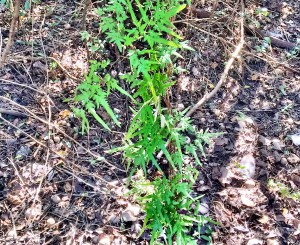
Japanese Climbing Fern can quickly cover natural vegetation. Spores and small plants can be potentially transported in pine straw. Climbing ferns are a problem for managed timber and home landscapes. Photo by L. Scott Jackson
$10 per person; lunch and materials included
http://fsp-workshop092817.eventbrite.com/
Or, call Okaloosa County Extension at (850) 689-5850
by Carrie Stevenson | Mar 3, 2017
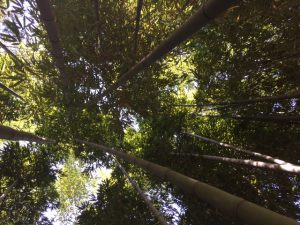
Bamboo shoots can grow as tall as 70 feet. Photo credit: Carrie Stevenson
Standing in the midst of a stand of bamboo, it’s easy to feel dwarfed. Smooth and sturdy, the hollow, sectioned woody shoots of this fascinating plant can tower as tall as 70 feet. Unfortunately, bamboo is a real threat to natural ecosystems, moving quickly through wooded areas, wetlands, and neighborhoods, taking out native species as it goes.
We do have one native species referred to as bamboo or cane (Arundinaria gigantea), which is found in reasonable numbers in southeastern wetlands and the banks of rivers. There are over a thousand species of true bamboo, but chief among the invasive varieties that give us trouble is Golden Bamboo (Phyllostachys aurea). Grown in its native Southeast Asia as a food source, building material, or for fishing rods, bamboo is also well known as the primary diet (99%) of the giant panda. In the United States, the plant was brought in as an ornamental—a fast growing vegetative screen that can also be used as flooring material or food. Clumping bamboos can be managed in a landscape, but the invasive, spreading bamboo will grow aggressively via roots and an extensive network of underground rhizomes that might extend more than 100 feet from their origin.
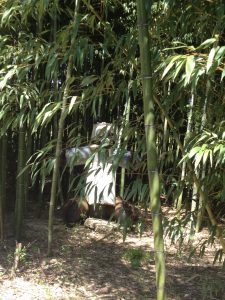
Whimsy art Panda in a bamboo forest at the Glendale Nature Preserve. Photo credit: Carrie Stevenson
As a perennial grass, bamboo grows straight up, quickly, and can withstand occasional cutting and mowing without impacts to its overall health. However, a repeated program of intensive mowing, as often as you’d mow a lawn and over several years, will be needed to keep the plant under control. Small patches can be dug up, and there has been some success with containing the rhizomes by installing an underground “wall” of wood, plastic, or metal 18” into the soil around a section of bamboo.
While there are currently no chemical methods of control specifically labeled for bamboo at this time, the herbicides imazapyr (trade name Arsenal and others) or glyphosate (Round-up, Rodeo) applied at high rates can control it. According to research on the topic, “bamboo should be mowed or chopped and allowed to regrow to a height of approximately 3 feet, or until the leaves expand. Glyphosate at a 5% solution or imazapyr as a 1% solution can then be applied directly to the leaves.” These treatments will often need to be repeated as many as four times before succeeding in complete control of bamboo.
Land managers should know that while imazapyr is typically a more effective herbicide for bamboo, it can kill surrounding beneficial trees and shrubs due to its persistence in the contiguous roots and soil. In contrast, glyphosate solutions will only kill the species to which it has been applied and is the best choice for most areas managed by homeowners.
Bamboo Control Publication
by Carrie Stevenson | Mar 2, 2017
Guest Blogger – Dr. Steve A. Johnson, Associate Professor & Extension Specialist, Department of Wildlife Ecology and Conservation, University of Florida
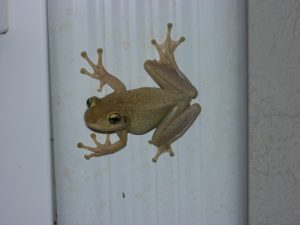
Cuban Treefrog. Photo credit: Steve Johnson
The National Invasive Species Council defines an invasive species as one that is introduced outside its native range where it causes harm (or is likely to) to the environment, economy, or human quality of life. The Cuban Treefrog in Florida qualifies as invasive under all three parts of this definition. Introduced from Cuba to Key West inadvertently in a shipment of cargo about 100 years ago, this frog is now established throughout Florida’s peninsula, and isolated records from numerous panhandle counties continue to accumulate. There are many records of Cuban Treefrogs from other states in the US, and even Canada. Most of these frogs originated in Florida and found their way to points beyond as hitchhikers on vehicles or as stowaways in shipments of ornamental plants. Fortunately, Cuban Treefrogs do not appear to have gained a permanent foothold—yet—outside of the Sunshine State.
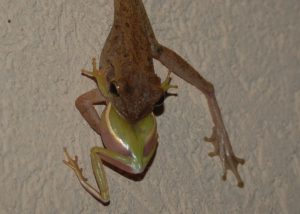
Cuban Treefrog eating a Green Treefrog. Photo Credit: Nancy Bennett
Cuban Treefrogs are well documented predators of Florida’s native treefrogs and are likely responsible for declines in native treefrog numbers, especially in suburban neighborhoods. Fortunately, research has shown that when native frogs (e.g., Squirrel and Green Treefrogs) are still present that they respond favorably to the removal of their invasive cousins. Cuban Treefrogs are known to seek shelter in electrical utility equipment or even a home air-conditioning units, and as they climb around they may cause short circuits, leading to costly repairs. They also invade homes, ending up in a toilet at times, and have also sent young children to the emergency room. The frogs exude a noxious skin secretion when handled, which is extremely irritating to mucous membranes, especially one’s eyes. So be sure to wash your hands thoroughly after handling a Cuban Treefrog.
To mitigate the negative impacts Cuban Treefrogs are having on Florida’s native wildlife, as well as their effects on our quality of life, I recommend that these invaders be captured and humanely euthanized. For tips on how to capture, identify, and humanely euthanize these frogs visit http://ufwildlife.ifas.ufl.edu/ and also read “The Cuban Treefrog in Florida”. Report sightings of this species outside of the Florida peninsula to Dr. Steve A. Johnson, and within the peninsula report them on EDDmapS.
by Rick O'Connor | Mar 2, 2017
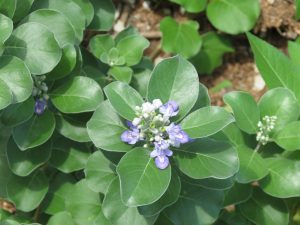
Beach Vitex Blossom. Photo credit: Rick O’Connor
Research shows that the most effective time to deal with an invasive species, both in terms of controlling or eradicating the species and money spent to do so, is early on…. What we call Early Detection Rapid Response. Beach vitex is a good candidate for this.
The first record for vitex in the Florida panhandle was in 2012. A local citizen in Gulf Breeze (Santa Rosa County) reported it on her beach and believed it may have come from Santa Rosa Island… it did. The barrier island location was logged on EDDmaps and the Gulf Breeze plants were removed. A quick survey of Florida on EDDmaps found that the only other location was in Duval County – 3 records there. So this was not a wide spread plant in our state and could be a rare case for eradication. That was until I surveyed Pensacola Beach on a bicycle and found 22 properties with it. Soon afterwards, it was found on the shores of Perdido Bay and concern set it that it might be more widespread than we thought.
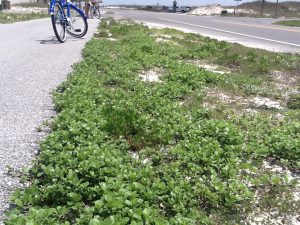
Vitex beginning to take over bike path on Pensacola Beach. Photo credit: Rick O’Connor
We tried to educate the property owners about the issue based on what we learned in South Carolina, where there is a state task force to battle the plant, and suggested methods of removal. Many property owners began the process, which can take several treatments over several years, and, with the help of University of West Florida students, removed all of the vitex from public land on Santa Rosa Island. We were feeling good that we might still be able to eradicate this plant from our county… and then I went for a hike in the Gulf Islands National Seashore… yep… found more… almost 10,000 m2 of the plant. UWF and Sea Grant have worked hard over the past year to remove these plants, and have removed all but one section. Recently I received an email letting me know that it was found in Franklin County. They have since logged this on EDDmaps and have begun the removal process. However, this begs the question… where else might this plant be in the panhandle?
Beach vitex (Vitex rotundifolia) is a salt tolerant plant that does well in dry sandy soils and full sun; it loves the beach. We have found it in dune areas above the high tide line. It was brought to the United States in the 1950’s for herbarium use. By the 1980,’s the plant was used in landscaping and sold at nurseries. It was first used in dune restoration in South Carolina after Hurricane Hugo, and that was when the trouble began.
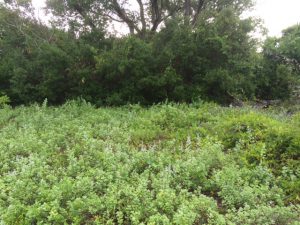
Vitex growing at Gulf Islands National Seashore that has been removed. Photo credit: Rick O’Connor
The plant grows very aggressively during the warmer months. It out competes native dune plants and quickly takes over. Growing 2-3 foot tall, this woody shrub has above ground rhizomes that can extend over 20 feet. Secondary roots begin to grow from the nodes along these rhizomes and it quickly forms an entangled mat of vines that blocks sun for some of the native plants. There has also been concern for nesting sea turtles. The rhizomes can over take a nest while incubation is occurring and entrapping the hatchlings. The plant has become such a problem in both North and South Carolina that a state task force has been developed to battle it. Vitex can spread either vegetative or by seed, both can tolerate being in salt water and can be dispersed via tides and currents. The plant has 1-2” ovate leaves and violet colored blossom, which can be seen in late spring and summer. The leaves become a rusty gray color during winter. The seeds, which are found in late summer and fall, are spherical and gray-purple in color. Vitex produces many seeds, an estimated 22,000/m2, and – in addition to being carried by the tide – can be transported by birds as well.
Again, we are hoping that the plant has been discovered early enough to control, if not eradicate, it… HOWEVER, WE NEED YOUR HELP. If you think you may have seen this plant along your coasts, please contact your county Sea Grant Extension Agent for advice on how to manage it.
by Sheila Dunning | Mar 1, 2017
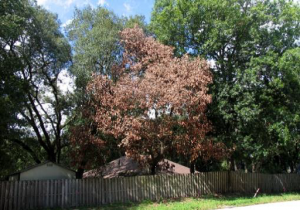
Swamp Redbay Tree infected with Laurel Wilt. Photo credit: Sheila Dunning
Many invasive plants and insects are introduced in packing materials, including 12 species of ambrosia beetles, which embed themselves in wood used as crates and pallets. While these tiny beetles don’t actually feed on wood, the adults and larvae feed on fungi that is inoculated into galleries within the sapwood by the females when they deposited their eggs. While the ambrosia fungus keeps the beetles alive, it kills the host tree. This is the projected fate of redbay trees (Persea borbonia) due to the Redbay Ambrosia Beetle.
First detected in the United States in a Georgia trap in 2002, Xyleborus glabratus, the Redbay Ambrosia Beetle, caused substantial mortality of redbay in northern Duval County, Florida in 2005. This ambrosia beetle introduces fungal spores, (Raffaelea lauricola) from specialized structures found at the base of their mandibles into the vascular system of plants when boring into host trees of the Lauraceae family. This insect and disease complex has collectively been named “Laurel Wilt.” Infected redbays, assafrass and avocado trees wilt and die within a few weeks or months.
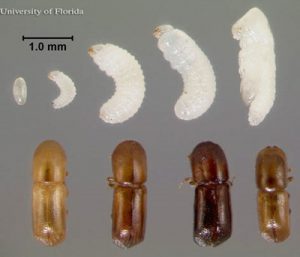
Ambrosia Beetle life stages
The Redbay Ambrosia Beetle is a shiny black, cylindrical insect about 2 mm in length. The males are flightless and the females can only fly short distances (1 – 1.5 miles). Therefore, host trees are often attacked many times and stands of redbays are damaged quickly. Small strings of compacted sawdust may protrude from the bark at the point of initial attack. However, wind and rain easily remove this sign leaving the only symptom to be the total browning of foliage in a section of the tree’s crown. Since the fungus blocks the xylem (water-carrying) tissue of the redbay, it appears to wilt while leaves remain attached. Once infected, the trees cannot be saved.
To avoid spreading the beetle and pathogen to new areas, the trees need to be cut down and wood or chips from the infested trees should not be transported off site. Where allowed, the materials should be burned on site. Protection of unaffected trees is possible with expensive pesticides if applied in a timely manner and using the correct techniques. Removal of all susceptible tree species is not recommended. The survivors may hold a genetic tolerance.















